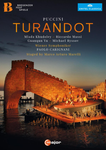|
Back
12/20/2015
Giacomo Puccini: Turandot
Mlada Khudoley (Turandot), Riccardo Massi (Calaf), Guanqun Yu (Liù), Michail Ryssov (Timur), Manuel von Senden (Altoum), Andrè Schuen (Ping), Taylan Reinhard (Pang), Cosmin Ifrim (Pong), Yasushi Hirano (A Mandarin), Prazský Filharmonický Sbor, Lukás Vasilek (Chorus Master), Bregenzer Festspielchor, Benjamin Lack (Chorus Master), Wiener Symphoniker, Paolo Carignani (Conductor), Felix Breisach (Video Director), Aron Kitzig (Video Designer), Gernot Gögele and Alwin Bösch (Sound Designers), Marco Arturo Marelli (Stage Director and Set Designer), Constance Hoffmann (Costume Designer), Davy Cunningham (Lighting Designer), Ran Arthur Braun (Stunt and Action Choreographer)
Recoding: live at the Bregenz Festival Seebühne, Bregenz, Austria (July 2015) – Running time: 125’
C Major Entertainment/UNITEL # 731408 (or Blu-Ray # 731504) (Distributed by Naxos of America) – Booklet in English, German and French and Italian – Subtitles in Italian, English, German, French, Spanish, Korean, Chinese, and Japanese

   
Puccini’s final, unfinished grand spectacle has always provided room for artistic interpretation…how does a stage director interpret the ice queen’s conclusive vision of love? Here’s another take of cerebral connect with questionable results.
By reviewing the amazing statistics referencing Marco Arturo Marelli’s stage technology, it perceptively renders greater importance on physical impressions versus music and characters. Thus, we have a mishmash of time sequences (via sets and costumes): impressively stoic 210-209 BC Qin Shi Huang terra cotta warriors act as aerial-to-subaqueous defensive brackets, the hors du temps Great Wall anchors beneath Lake Constance, Calaf (an embodiment of Puccini while on life support) dresses in transplanted 1920’s-type Eastern European garb, three comical Mousquetaires chinois cloyingly hide behind Lucha libre masks, a Mandarin harlequin pantomimes quasi-comical relief, commedia dell’arte facial facades evince macabre exposure, Mao Tse Tung’s Cultural Revolution enlivens choral attentive marbled transmogrification along with a backpack-laden Liù. What? The picture confuses and is non-fluent.
Marelli is fixated on a Puccini-Calaf connect that drains the Italian’s powerful score. Constance Hoffman runs a gamut of cross-costuming, depicting an array of textures, auras and eras: in no way does the wardrobe-designate congeal and heighten this Turandot. Likewise, it confuses and buries continuity.
Vocally-speaking singers are up and down. Mlada Khudoley’s difficult score is magnified by her highly brash and wavy vibrato. One can’t blame her for dilution of character as she comes across as having assertive, faintly-loving approaches (by Marelli) alongside inappropriate gesticulations that mismatch the Adami/Simoni libretto. In no way does Turandot signify power (she’s rather weakly amorous.) Instead, she exudes vulnerability, and she crumbles Turandot’s idée fixe. While Timur delivers an impressive aria in the beginning of Act III, Michail Ryssov’s stamina loses steam on the closing note of “Nessun dorma.”
Constance Hoffman’s Altoum and Timour similar dressings aid in a befuddling, blurred vision. Musically-speaking, the saving grace can be accredited to Guanqun Yu’s portrayal of Liù. She plays her character with warmth, concern, passion and beautiful pitch. Set amidst strong string accompaniment, her buttery and impassioned “Tanto amore segreto” has fervor and pathos, yet nothing beyond.
If one is gnarled by this Turandot, fingers points to Mr. Marelli. In addition to grinding blacksmiths, we have hi-tech emoji smiles and frowns on a rotating x-y-z axis. Though these extravagant techniques evoke unstoppable stimuli, the basics of Puccini’s posthumous work doesn’t carry the baton forward in creating a newly fashioned, well-expressive delivery.
Paolo Carignani’s pacing is brisk and forthright; however, the music is buried beneath the surface, playing second fiddle to the stage’s incongruous antics. Alas, here, Puccini’s score simply lacks heart and soul.
One can have all the tonnage imaginable alongside grandeurs of pixel pitch and electronic circuitry, but in the end, does it elucidate and reveal a coherent message since Puccini’s demise on November 29, 1924? Hardly.
Christie Grimstad
|